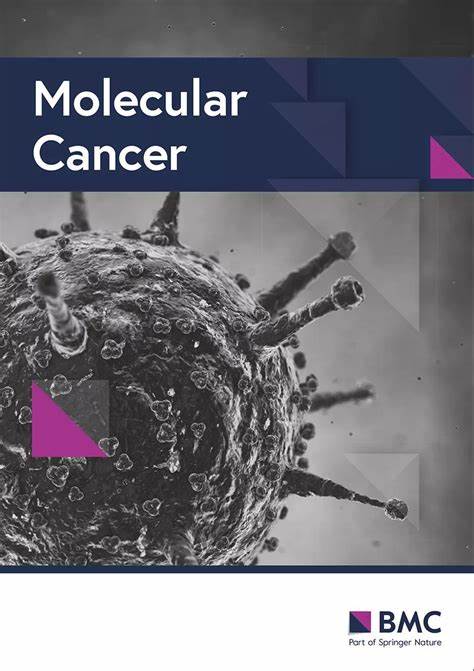用于增强放射治疗的工程化多功能纳米粒子:三合一癌症治疗方法
IF 27.7
1区 医学
Q1 BIOCHEMISTRY & MOLECULAR BIOLOGY
引用次数: 0
摘要
临床癌症治疗方式包括放疗作为一线治疗方法之一,用于治疗近三分之二的癌症患者。癌症的联合治疗正变得非常流行,多种治疗方法及其药理作用有望提供协同结果。基于纳米技术的联合治疗方法正在成为一种更有效的策略,因为它的优点包括同时装载多种药物,由外部或内部刺激控制的按需药物递送,针对特定部位,以及将物理治疗方式(如放射、热疗法等)与化学干预(如化疗、免疫疗法等)结合起来的潜力。我们报道了一种由涂有金的多功能脂聚合物杂化纳米系统介导的放疗和化疗组合,证明了使用单个纳米系统的三种不同功能:a)放射增敏,b)辐射触发的药物递送,以及c)作为x射线/CT造影剂的应用。这种脂质聚合物混合纳米颗粒是用一种改进的水凝胶分离方法合成的,它装载了一种天然植物来源的抗癌剂“卡啡酮”。这些纳米颗粒进一步进行原位还原以获得金表面涂层,从而增强放射敏感性,辐射触发药物传递和x射线/CT成像。这种使用多功能纳米系统的方法利用了脂肪-聚合物混合系统的生物相容性来装载药物,药物释放辐射的精确时空可控性,以及植物来源的抗癌剂“卡啡酮”的细胞毒性。联合方法对乳腺癌(p = 0.0002)、胰腺癌(p < 0.0001)和胶质母细胞瘤(p < 0.0001)的体外治疗效果显著。纳米系统作为x射线/CT造影剂的应用已经在荷瘤小鼠体内得到证实,在健康小鼠中进行的安全性和组织病理学评估显示没有不良影响。联合用药可显著提高乳腺荷瘤小鼠的存活率(p = 0.01)。设计的多功能纳米颗粒增强了放射治疗,并触发了肿瘤部位的药物释放,触发了包封化疗药物的作用,同时提供了图像引导。本文章由计算机程序翻译,如有差异,请以英文原文为准。
Engineered multifunctional nanoparticles for enhanced radiation therapy: three-in-one approach for cancer treatment
Clinical cancer treatment modalities include radiation as one of the first-line therapies used for treating almost two-thirds of cancer patients. Combinational therapy for cancer is becoming extremely popular, with multiple therapies and their pharmacological effects expected to provide a synergistic outcome. The nanotechnology-based combinational therapeutic approach is emerging as a more effective strategy, for its advantages include simultaneous loading of multiple drugs, on-demand drug delivery controlled by external or internal stimulus, targeting a particular site, and the potential to combine physical treatment modalities (like radiation, thermal therapies, etc.) with chemical interventions (like chemotherapy, immunotherapy, etc.). We report a combination of radiotherapy and chemotherapy mediated by a multifunctional lipo-polymeric hybrid nanosystem coated with gold, demonstrating the three different functionalities using a single nanosystem: a) radio sensitization, b) radiation-triggered delivery of drugs, and c) application as an X-ray/CT contrast agent. The lipo-polymeric hybrid nanoparticles, synthesized using a modified hydrogel isolation method, were loaded with a natural plant-derived anti-cancer agent “Caflanone.” These nanoparticles were further subjected to in-situ reduction for a surface coating of gold, which provided enhanced radiosensitivity, radiation triggered drug delivery and X-ray/CT imaging. This approach using a multifunctional nanosystem leverages the biocompatibility of the lipo-polymeric hybrid system for the loading of drugs, precise spatiotemporal controllability of radiation for drug release, and the cytotoxicity of the plant-derived anti-cancer agent “Caflanone.” A significant therapeutic efficacy in vitro against breast cancer (p = 0.0002), pancreatic cancer (p < 0.0001), and glioblastoma (p < 0.0001) was demonstrated with the combinational approach. The application of the nanosystem as an X-ray/CT contrast agent has been shown in vivo in tumor-bearing mice and the safety profile and histopathology evaluated in healthy mice showed no adverse effects. A significant increase (p = 0.01) in the survival of breast tumor-bearing mice treated with a combinational approach was also demonstrated. The engineered multifunctional nanoparticles enhanced the radiation therapy and triggered the drug release at the tumor site, triggering the action of encapsulated chemotherapeutic agents while providing image guidance.
求助全文
通过发布文献求助,成功后即可免费获取论文全文。
去求助
来源期刊

Molecular Cancer
医学-生化与分子生物学
CiteScore
54.90
自引率
2.70%
发文量
224
审稿时长
2 months
期刊介绍:
Molecular Cancer is a platform that encourages the exchange of ideas and discoveries in the field of cancer research, particularly focusing on the molecular aspects. Our goal is to facilitate discussions and provide insights into various areas of cancer and related biomedical science. We welcome articles from basic, translational, and clinical research that contribute to the advancement of understanding, prevention, diagnosis, and treatment of cancer.
The scope of topics covered in Molecular Cancer is diverse and inclusive. These include, but are not limited to, cell and tumor biology, angiogenesis, utilizing animal models, understanding metastasis, exploring cancer antigens and the immune response, investigating cellular signaling and molecular biology, examining epidemiology, genetic and molecular profiling of cancer, identifying molecular targets, studying cancer stem cells, exploring DNA damage and repair mechanisms, analyzing cell cycle regulation, investigating apoptosis, exploring molecular virology, and evaluating vaccine and antibody-based cancer therapies.
Molecular Cancer serves as an important platform for sharing exciting discoveries in cancer-related research. It offers an unparalleled opportunity to communicate information to both specialists and the general public. The online presence of Molecular Cancer enables immediate publication of accepted articles and facilitates the presentation of large datasets and supplementary information. This ensures that new research is efficiently and rapidly disseminated to the scientific community.
 求助内容:
求助内容: 应助结果提醒方式:
应助结果提醒方式:


